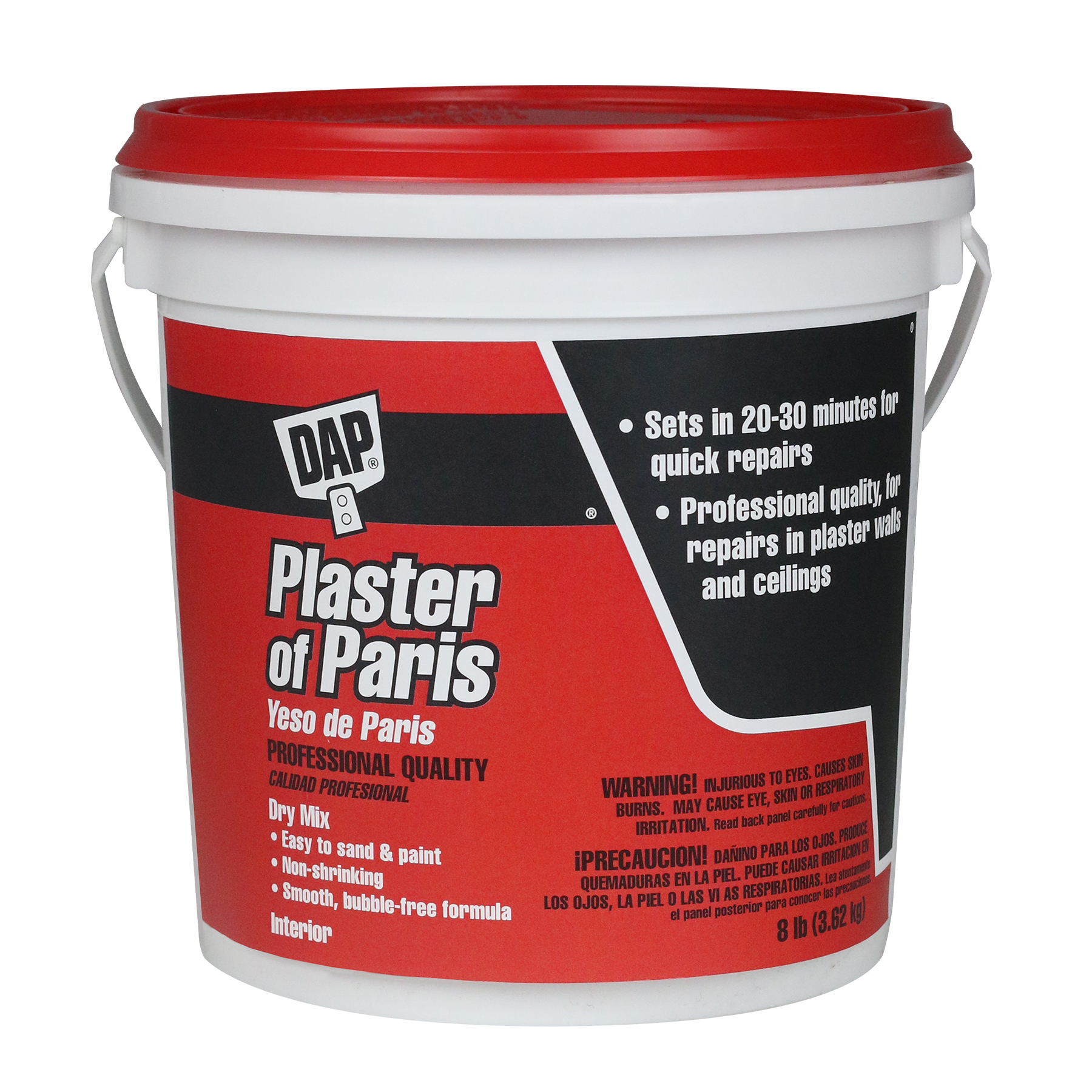Are you staring at those unsightly wall imperfections, wondering how best to tackle them? Whether you’re a seasoned DIY enthusiast or just beginning to dip your toes into home improvement waters, the decision between plaster of Paris and spackle can feel daunting.
But don’t worry, you’re not alone! Understanding the differences between these two popular wall repair materials is crucial to achieving a smooth and flawless finish in your home. This knowledge will not only save you time but also ensure your efforts deliver professional-looking results.
Stick around, because by the end of this article, you’ll have the insights you need to confidently choose the right product for your project, transforming your living space with ease.
Composition And Ingredients
Understanding the composition and ingredients of Plaster of Paris and Spackle helps in choosing the right material for your project. Both have unique properties that make them suitable for different tasks. Knowing what they are made of can guide you to make the best choice.
Plaster Of Paris: Composition And Ingredients
Plaster of Paris is primarily made from gypsum. It’s processed by heating gypsum to about 150°C. This heating process removes water, creating a fine powder. When mixed with water, it hardens quickly. The rapid setting time makes it ideal for molds and casts. It has a smooth finish and is often used in art and construction.
Spackle: Composition And Ingredients
Spackle contains a mixture of gypsum or calcium carbonate. Other additives include binders and fillers. These components create a thicker consistency than Plaster of Paris. It is designed for small repairs on walls and ceilings. The paste-like texture makes it easy to apply. It dries slowly, allowing for adjustments during application.
Both Plaster of Paris and Spackle serve specific purposes in repair and construction. Knowing their composition aids in selecting the right product for your needs.
:max_bytes(150000):strip_icc()/joint-compound-vs-spackle-5180404-hero-80643919571d45a3ab1387d5deed412b.jpg)
Credit: www.thespruce.com
Applications And Uses
Understanding the applications and uses of Plaster of Paris and Spackle can help in choosing the right material. They serve different purposes in various projects. Knowing their uses can make home improvement or artistic tasks easier and more efficient.
Home Improvement Projects
Plaster of Paris is often used for repairs in homes. It’s great for creating smooth surfaces on walls and ceilings. Use it for decorative elements like moldings and cornices. It sets quickly, making it ideal for fast projects.
Spackle is perfect for filling small holes and cracks. It works well on drywall and plaster surfaces. It’s easy to apply and sand, offering a seamless finish. Great for minor repairs before painting.
Artistic And Craft Uses
Artists love Plaster of Paris for sculptures and molds. It captures fine details, making it perfect for intricate designs. It’s also used for casting and creating models. A favorite in art classes and studios.
Spackle can be used creatively in crafts. It adds texture to paintings and mixed media artworks. It’s lightweight and dries quickly, allowing for fast project turnover. Ideal for school projects and DIY crafts.
Durability And Longevity
Durability and longevity are crucial factors in material selection. Whether fixing a wall or creating art, understanding lifespan helps make informed choices. Plaster of Paris and Spackle are common materials. Each has distinct qualities impacting durability. Knowing these differences aids in selecting the best fit for your needs.
Plaster Of Paris: Durability
Plaster of Paris is known for its solid finish. It forms a hard surface that resists damage. Ideal for permanent repairs, it offers strength. Once dry, it withstands wear and pressure. Its durability makes it suitable for structural projects.
Spackle: Durability
Spackle provides a flexible finish. It adapts to minor movements in walls. Though softer than plaster, it doesn’t crack easily. Great for small repairs, it handles frequent adjustments. Its resilience is perfect for non-structural tasks.
Plaster Of Paris: Longevity
Plaster of Paris lasts long with proper care. It maintains its form over time. Ideal for long-term projects, it ensures a stable appearance. Regular maintenance extends its lifespan further. Once set, it remains sturdy and reliable.
Spackle: Longevity
Spackle offers decent longevity. It holds up well for temporary fixes. Best for short-term needs, it retains flexibility. Regular touch-ups may be needed for lasting results. Its longevity suits minor and frequent repairs.
Ease Of Use
Plaster of Paris is easy to mix and apply, perfect for larger repairs. Spackle is convenient for small holes and quick fixes. Both materials offer straightforward application processes, catering to different project needs.
When tackling home improvement or repair projects, choosing the right materials can make or break your efforts. Plaster of Paris and Spackle are two popular options for patching and repairing walls. But how easy are they to use? Let’s dive into their ease of use, and see which one might better suit your needs.Mixing And Preparation
Plaster of Paris requires mixing with water to achieve the right consistency. This might sound simple, but getting it just right can be tricky. It hardens quickly, so you must work fast, which can be stressful if you’re not experienced. Spackle, on the other hand, comes pre-mixed in a convenient tub. Just open the lid, and you’re ready to go. This pre-mixed nature makes it much more user-friendly, especially for beginners or those who prefer a straightforward approach.Application Process
Applying Plaster of Paris can be a bit of an art form. It requires a steady hand and some finesse to ensure it spreads evenly and fills gaps properly. It can be challenging to smooth out, especially if you’re in a hurry. With Spackle, the application is a breeze. It spreads easily and smoothly, even if you have little experience with wall repairs. Its forgiving nature allows for easy adjustments and corrections, making it ideal for quick touch-ups or minor repairs. Plaster of Paris sets quickly, usually within minutes. This rapid drying time means you must be quick on your feet and have everything ready before you start. If you’re not, you might find yourself scrambling to finish before it hardens. Spackle dries more slowly, giving you ample time to adjust and perfect your work. This flexibility can reduce stress and make the whole process more enjoyable. Plus, you won’t have to rush to clean your tools immediately after use.Cleanup And Maintenance
Cleaning up after using Plaster of Paris can be a hassle. If it dries on your tools or surfaces, it can be tough to remove. You’ll need to act quickly to clean everything up before it sets. Spackle is much more forgiving in terms of cleanup. It easily wipes off tools and surfaces, even after it has dried. This ease of maintenance can save you time and effort, especially if you’re juggling multiple tasks. Have you ever found yourself in a pinch, wishing your repair job was simpler? Your choice of material could be the key. Whether you need speed or flexibility, understanding these differences can guide you to a smoother DIY experience. Which will you choose for your next project?Drying Time
Understanding the drying time of Plaster of Paris and Spackle helps in planning home repairs. Each material has unique drying properties that affect your project timeline. Knowing these differences ensures efficient work and better results.
Plaster Of Paris: Quick Drying
Plaster of Paris dries fast, usually within 20 to 30 minutes. This quick drying time allows for rapid project progression. It is ideal for smaller repairs where speed is essential. Once mixed, it hardens quickly, so prepare only what you need.
Spackle: Slower And Steady
Spackle takes longer to dry, ranging from 1 to 2 hours. This slower drying time offers more flexibility for adjustments. It is perfect for larger areas or detailed work. Spackle provides ample time to achieve a smooth finish.
Factors Affecting Drying Time
Temperature and humidity influence drying times for both materials. Higher temperatures speed up the drying process. Increased humidity slows down the hardening. Always check environmental conditions before starting your project.
Choosing Based On Drying Needs
Consider your project size and timeline when choosing between the two. For quick repairs, Plaster of Paris is suitable. For detailed work, Spackle’s slower drying allows precision. Select the material that best aligns with your project demands.

Credit: www.dap.com
Cost Comparison
Comparing costs is crucial when deciding between Plaster of Paris and Spackle. Both materials serve specific purposes in construction and home improvement. Understanding their price differences helps make informed choices.
Plaster Of Paris: Cost Efficiency
Plaster of Paris is often cheaper. It is a popular choice for larger projects. This material comes in bulk, which reduces overall costs. The price per pound is usually lower than Spackle.
Spackle: Price Considerations
Spackle tends to be more expensive. It is sold in smaller containers. This is suitable for minor repairs and touch-ups. The higher cost reflects its convenience and ease of use.
Long-term Value
Both materials have unique benefits. Plaster of Paris is cost-effective for big jobs. Spackle provides durability for smaller fixes. Choosing the right one depends on project size and budget.
Environmental Impact
Choosing between Plaster of Paris and Spackle is not just about repair efficiency. Their environmental impact is crucial for eco-conscious homeowners. This section explores how each product affects the planet.
Plaster Of Paris: Impact On Environment
Plaster of Paris is made from gypsum. Gypsum mining can disrupt local ecosystems. It generates dust which affects air quality. During production, it emits carbon dioxide. This contributes to greenhouse gases. Disposal can be tricky. It doesn’t decompose easily and can fill landfills.
Spackle: Environmental Considerations
Spackle often contains synthetic materials. These materials can be harmful if not disposed of properly. It might include acrylics and resins. They release volatile organic compounds (VOCs). VOCs contribute to air pollution. Disposal of spackle must be done responsibly. It can contaminate soil and water.
Recycling And Waste Management
Recycling options for Plaster of Paris are limited. It can be reused in construction, but not always feasible. Spackle recycling depends on its composition. Some types are easier to recycle. Both products require careful waste management. This ensures minimal environmental harm.
Impact On Natural Resources
Gypsum extraction depletes natural resources. It affects landscapes and habitats. Spackle production uses petrochemicals. This relies on non-renewable sources. Both have implications for sustainability. Choosing eco-friendly alternatives can reduce this impact.
Safety Considerations
Choosing between plaster of Paris and spackle requires careful consideration of safety. Plaster of Paris can cause skin irritation, so gloves are recommended. Spackle is generally safer but can produce dust; wearing a mask is advisable. Always ensure proper ventilation when working with either material.
When you’re tackling home improvement projects, choosing the right material is crucial for both effectiveness and safety. Plaster of Paris and spackle are common materials used for repairs, but they have different safety considerations you need to be aware of. Understanding these can help you make informed decisions and ensure a safe working environment.Dust Inhalation
Both plaster of Paris and spackle can create dust during mixing and sanding. This dust can irritate your respiratory system. Wearing a dust mask is essential to prevent inhalation. Have you ever noticed how sneezing fits can disrupt your focus? Ensuring proper ventilation in your workspace can help minimize dust accumulation. Open windows or use fans to keep the air clean.Skin Contact
Plaster of Paris can cause skin irritation due to its drying properties. It can even cause burns if left on the skin for too long. Wearing gloves while handling it is a smart move. Spackle is generally less harsh, but it can still dry out your skin. Moisturizing afterwards can help keep your hands from becoming dry or cracked.Eye Protection
Getting dust in your eyes can be painful and potentially harmful. Safety goggles are recommended when mixing or sanding these materials. Have you ever felt the sting of something in your eye? It can derail your project quickly. Ensuring you have proper eye protection can save you from unnecessary discomfort and keep your project on track.Storage Concerns
Storing these materials properly is crucial for both safety and longevity. Plaster of Paris should be kept in a dry area to prevent it from hardening prematurely. Spackle can dry out if not sealed properly, rendering it useless. Check the lids and storage bags to ensure they are tightly closed.These safety considerations are not just guidelines—they’re essential steps to protect yourself and your work environment. Have you thought about what measures you can take to ensure a safer project next time? Taking a few extra minutes to prepare can make all the difference.
Common Mistakes
Mixing up Plaster of Paris and spackle often leads to issues in home repairs. Plaster of Paris sets quickly, ideal for casting but not for filling holes. Spackle, softer and slower to dry, suits wall repairs but can crack if used incorrectly.
Understanding their properties helps avoid common mistakes.
When working on home improvement projects, choosing between Plaster of Paris and spackle can be tricky. Both materials are useful for repairs, but using them incorrectly can lead to disappointing results. Let’s explore some common mistakes to avoid to ensure your project goes smoothly.1. Misunderstanding The Purpose
Many people mistakenly use Plaster of Paris for filling small holes or cracks in walls. This material is better suited for creating molds or casting sculptures. Spackle, on the other hand, is designed specifically for wall repairs, making it the right choice for patching up small imperfections.2. Incorrect Mixing
Plaster of Paris requires precise mixing with water to achieve the right consistency. Too much water will make it too runny and weak, while too little will make it hard to apply. Spackle, which often comes pre-mixed, eliminates this step, making it more user-friendly.3. Ignoring Drying Times
Rushing through the drying process is a common mistake. Plaster of Paris sets quickly, but it needs adequate time to dry completely before painting over it. Spackle may take longer to dry, but patience is crucial to avoid uneven surfaces. Have you ever painted over a wet patch, only to find cracks later?4. Over-sanding
Sanding is essential for a smooth finish, but overdoing it can ruin your repair. With Plaster of Paris, excessive sanding can weaken the structure. Spackle is more forgiving, but you still need to sand gently. Always use fine-grit sandpaper and light pressure.5. Skipping Primer
Skipping primer after applying either material can result in poor paint adhesion. Plaster of Paris and spackle both absorb paint differently than the surrounding wall. Applying a primer ensures a uniform finish and prevents the repaired area from standing out. Avoid these common pitfalls, and you’ll be on your way to a flawless repair. Remember, understanding your materials and their unique properties can make all the difference in your home improvement projects. What other tips have you found helpful in your DIY repairs?Expert Tips And Recommendations
Choosing between Plaster of Paris and Spackle can be confusing. Both have unique properties and benefits. Expert tips can help make the right choice for your project. Understanding these insights ensures a smooth and successful application.
Understanding Your Project Needs
Consider the size of the area needing repair. Small repairs often benefit from Spackle. It dries quickly and is easy to apply. Large areas may require Plaster of Paris. It offers strong coverage and durability. Analyze the extent of the repair to decide.
Surface Type Considerations
Identify the surface type before choosing. Plaster of Paris is ideal for walls. It bonds well with drywall and plasterboard. Spackle works better on wood and smaller patches. Match the product to the surface for best results.
Application Techniques
Proper application ensures a smooth finish. Mix Plaster of Paris thoroughly before use. Apply with a trowel for even coverage. Spackle needs minimal preparation. Use a putty knife for small fixes. Follow application guidelines carefully.
Drying Time And Finish
Consider drying time for each product. Plaster of Paris takes longer to dry. It offers a smooth and professional finish. Spackle dries quickly, ideal for speedy repairs. Choose based on time constraints and desired finish.
Cost And Availability
Budget plays a role in decision-making. Spackle is generally more affordable. It’s widely available in hardware stores. Plaster of Paris may cost more but offers quality. Compare prices and availability before purchasing.

Credit: www.youtube.com
Frequently Asked Questions
What Is Plaster Of Paris Used For?
Plaster of Paris is used for crafting, sculpting, and repairs. It sets quickly. Ideal for mold-making.
How Does Spackle Differ From Plaster Of Paris?
Spackle is used for filling small holes and cracks in walls. It’s lighter and easier to sand.
Can I Use Plaster Of Paris On Walls?
Yes, but it’s not ideal for walls. Better for crafts and molds. Use spackle for walls.
Is Spackle Waterproof?
No, spackle is not waterproof. Use it indoors on dry surfaces. Consider waterproof sealants for wet areas.
Which Dries Faster, Spackle Or Plaster Of Paris?
Plaster of Paris dries faster. Usually within minutes. Spackle takes longer but is easier to sand.
Conclusion
Choosing between Plaster of Paris and Spackle depends on your project needs. Plaster of Paris works well for molding and casting. It’s ideal for detailed shapes. Spackle, on the other hand, suits small repairs. Great for filling holes and cracks.
Easy to use for quick fixes. Consider drying time and finish. Plaster of Paris dries fast but needs sealing. Spackle offers smooth results with minimal effort. Both options are useful in home projects. Evaluate your task requirements to select the best fit.
Each has its unique advantages. The right choice enhances your project’s success.





